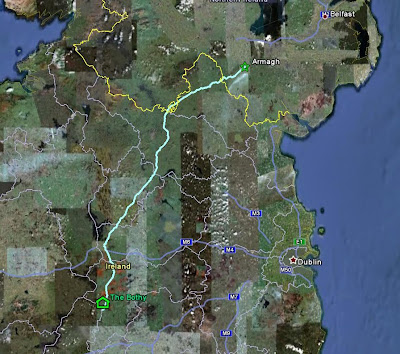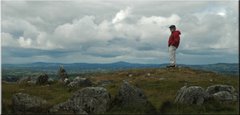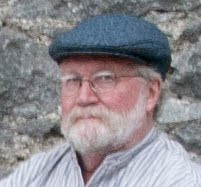Day 7 of 35: Tuesday, August 10, 2010
 Our route from the Bothy in Birr to Armagh. The yellow line in this Google Earth image is the border between the Republic of Ireland and Northern Ireland.
Our route from the Bothy in Birr to Armagh. The yellow line in this Google Earth image is the border between the Republic of Ireland and Northern Ireland.
This was a day of driving North to Armagh, the first leg of the first of two sorties into Northern Ireland that we had planned. This venture's main goal was to spend a couple of nights at a Bed and Breakfast on the Northern coast of County Antrim, a scenic highlight of the island, with a short stop at the city of Armagh along the way.
 In Monaghan city, County Monaghan, a border area. While Monaghan is in the Republic of Ireland, the fuel pumps at the gas station we used there were priced in pounds sterling.
In Monaghan city, County Monaghan, a border area. While Monaghan is in the Republic of Ireland, the fuel pumps at the gas station we used there were priced in pounds sterling. Armagh was long the astronomy capital of Ireland, and the Armagh Observatory is still an active center of astronomical research whose score of astronomers do research around the world in various astronomical specialties. The observatory itself, built in the 18th century, is no longer the site of active observing, but is the enterprise's headquarters, a site of high historical importance in astronomy, housing offices, historic instruments, and archives going back more than two centuries. The Observatory shares its hill with a modern, internationally-acclaimed planetarium, and both institutions do wonderful work in public outreach and education.

 The Armagh Planetarium patio (above) and part of the facility's impressive display area (below). The Armagh Planetarium has a very fine interactive web site, in which you can take a virtual tour -- of your own directing -- through the building.
The Armagh Planetarium patio (above) and part of the facility's impressive display area (below). The Armagh Planetarium has a very fine interactive web site, in which you can take a virtual tour -- of your own directing -- through the building. During the 1800's, Birr and Armagh formed a vital astronomical axis, with astronomers frequently traveling between the sites, probably along a route not much different from the one Diane and I took on this day.
My earlier communications with Observatory and Planetarium hadn't mentioned this particular short visit, since it was to be just a very brief stop on our way to somewhere else. The plan was to return a couple of weeks later for a longer stay after I had a chance to dig into the archives at Birr Castle for more details about the relationships among the astronomer Earls of Rosse in Birr, Armagh Observatory's founding Robinson family, and American astronomers of the era. That way, I could more clearly articulate what I would be looking for and use time more efficiently than if I had scheduled such a visit this early in our trip.
The trip itself to Armagh city was uneventful and beautiful, through prosperous-looking farm country most of the way. As we had been told, the transition from Ireland to Northern Ireland was almost undetectable, by far the most nearly invisible international border I have ever seen (not that I've seen many.) The only clues were a slight change in the road surface (which can often happen at the interface between two road-maintenance districts), a change in the color of the shoulder stripes from yellow to white, and a change in the speed limit signs from kph to mph.
While the approaching countryside seemed prosperous, the center of Armagh itself seemed somewhat worn and almost gloomy. The hotel in which we had our reservation, the Charlemont Arms in the heart of old Armagh city, was horrible: creaky floors, dim lights in meandering hallways, a broken elevator (which looked like it had been broken for a very long time), and, worst of all, an overpowering stench of mildew in our room.
We didn't bring our bags in, but immediately went in search of another hotel -- and found a gem: the Armagh City Hotel, which, in addition to being modern and clean, was in a superb location for viewing the city. It helped that we had a wonderful room for that, a second-floor corner room facing the hills of old Armagh and the Observatory.
 View from our room's window in the Armagh City Hotel. Two green domes of the Armagh Observatory can be seen in a thicket of trees at the horizon just left of center; the larger dome of the Planetarium is slightly below them and to the right of center.
View from our room's window in the Armagh City Hotel. Two green domes of the Armagh Observatory can be seen in a thicket of trees at the horizon just left of center; the larger dome of the Planetarium is slightly below them and to the right of center. After a brief rest, it was off to the goal of our stop in Armagh, the Planetarium and Observatory area, especially the fabulous Astropark which shares the hill with them. The park meanders around and up the hill from the Planetarium to the old Observatory buildings.
 Goofing around at Saturn. The other big stainless steel ball represents Jupiter, the Sun's size is represented by the arches in the background, and the marble-sized balls for the inner planets cannot be seen in this view.
Goofing around at Saturn. The other big stainless steel ball represents Jupiter, the Sun's size is represented by the arches in the background, and the marble-sized balls for the inner planets cannot be seen in this view. The first part of the Park's meander is a scale-model solar system, laid out in a linear way. At the end of the model solar system is a set of nested cubes (a structure called the "Hypercube") illustrating exponential notation for youngsters in a striking and clear way:
... and after the hypercube, the Park's path climbs the lush green "Hill of Infinity," on which a strolling person can travel in exponential and well-marked steps from Pluto to the edge of the observable universe, the last marked by a modern-day ring of standing stones at the hill's summit, aligned to the Sun's rising and setting points at the solstices and equinoxes.
Like so much else on the island, either North or South, the Park is extremely child-friendly. There is no admission charge for the Park, no fences or gates, no "keep off the grass" signs, and everything is designed to be touched as well as seen.
==================================
The slides on sharrington.net for this day are merged with those for the next, and a link to that combined slideshow will appear at the end of tomorrow's installment.
==================================
The slides on sharrington.net for this day are merged with those for the next, and a link to that combined slideshow will appear at the end of tomorrow's installment.
==================================
Next: August 11, 2010 -- Armagh to the North Coast of Antrim
Previous: August 9, 2010 -- Waterford
Beginning of the series: Prologue, August 2
Previous: August 9, 2010 -- Waterford
Beginning of the series: Prologue, August 2





No comments:
Post a Comment